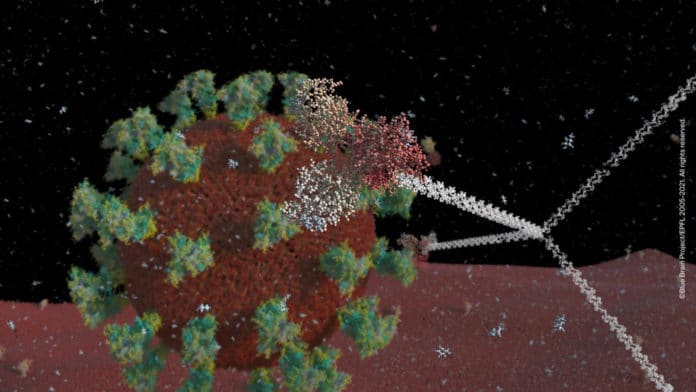COVID-19 can result in severe lung injury. It remained to be determined why diabetic individuals with uncontrolled glucose levels are more prone to develop the severe form of COVID-19.
Past studies demonstrated that elevated glucose levels and sustained aerobic glycolysis in monocytes directly promote viral replication. But how elevated glucose levels help this replication remains unclear.
In the EPFL‘s Blue Brain Project, scientists assembled an AI tool to determine the answer to the question.
The AI tool can read several scientific papers, extract the knowledge and assemble the answer.
There are more than 400,000 scholarly articles have been published. The dataset of all these articles, called the COVID-19 Open Research Dataset (CORD-19), includes full-text papers related to COVID-19, SARS-CoV-2, and other coronaviruses. The dataset is available for data mining.
Now, the coalition behind this data set has challenged AI scientists to apply their skills in natural language processing and other machine learning techniques to generate new insights that may help in the ongoing fight against COVID-19.
Prof. Henry Markram, Founder, and Director of the Blue Brain Project said, “Since early 2020, Blue Brain has been proactively contributing to the fight against COVID-19. With this call to action, we realized we could use our Machine Learning technologies and Data and Knowledge Engineering expertise to develop text and data mining tools to help the medical community. Blue Brain set out to answer one of the most puzzling aspects of this pandemic – why some people get very sick, while others are completely unaffected.”
Accordingly, Blue Brain built and trained machine-learning models to mine these papers and extract structured information from text sources. A simple analysis by this text mining toolbox, ‘Blue Brain Search’ of the CORD-19v47 dataset, revealed papers that all pointed to glucose metabolism as the most frequently mentioned biological variable.
Using a unifying python framework called Blue Graph, the team was able to construct specific knowledge graphs, focusing on the findings that considered glucose in the context of respiratory diseases, coronaviruses, and COVID-19. This allowed them to explore the role of glucose across several levels, including superficial symptomatic associations, the deepest biochemical mechanisms implicated in the disease, etc.
The outcomes revealed the possible cause of elevated blood glucose levels. It was either caused by abnormal glucose metabolism or induced during hospitalization, drug treatments, or IV administration.
This approach correlated extremely well with COVID-19 severity across the population and revealed how elevated glucose helps virtually every step of the viral infection.
Blue Brain’s Molecular Biologist Dr. Emmanuelle Logette, said, “Subsequently, in the paper, we discuss the potential consequences of this hypothesis and propose areas for further investigation into diagnostics, treatments, and interventions that may help to reduce the severity of COVID-19 and help manage the public health impact of the pandemic.”
Prof. Henry Markram said, “Scientists immediately went to work when the pandemic started and within a year published over a hundred thousand papers. But, can anyone read so many papers? Can anyone see and understand all the patterns across all this research?”
“Fortunately, the coalition behind the CORD-19 dataset convinced all subscription publishers to bring these papers over the subscription paywall and make them openly accessible so that they can be mined with modern machine learning and knowledge engineering technologies.”
“With access to the CORD-19 dataset, Blue Brain quickly assembled an AI tool and targeted it to try and find out why some get sick and others not. Is it enough to say that older people are more vulnerable? We must find out why. Why do some healthy people die from COVID-19? Why do so many people die in the ICU?”
“To answer these questions, we directed our AI to trace every step of the viral infection from the moment the virus enters the lungs until the time when the virus breaks out of the cells in the lungs and spreads throughout the body to infect the organs.”
“We also built the virus at an atomistic level and developed a computational model of the infection so we could try to test what was coming out of the literature. I think we did find the most likely reason why some people get sicker than others.”
Using Blue Brain BioExplorer, scientists demonstrated the impacts of high glucose in airway surface liquid on the primary step of infections in the lung. This explains the susceptibility of the virus in at-risk patients.
Prof. Markram said, “Pioneering Simulation Neuroscience to better understand the brain has numerous collateral benefits. This study shows how Blue Brain’s computing technologies and unique team of multi-disciplinary experts can quickly be redirected to help in a global health crisis.”
“The COVID-19 study also shows why we believe that computational tools are so important to help us understand the brain. The problem is even bigger. There are several million scientific papers that one would need to read and understand to work out what we know about the brain. Does anyone know what we know? But, machines can read so many papers.”
“This is the reason that the Blue Brain has developed some of the most advanced knowledge engineering, mathematical and machine learning accelerator technologies. This solves only a part of the challenge.”
“With an AI tool that can read all these papers, we would still only know only a small fraction of what the brain contains and how it works. But building model brains using design principles helps us to try and complete the picture.”
Journal Reference:
- Logette E et al. A Machine-Generated View of the Role of Blood Glucose Levels in the Severity of COVID-19. Front. Public Health 9:695139. DOI: 10.3389/fpubh.2021.695139
